“Evil Most Disastrous”: The Agony and Ecstasy of Absinthe
There is a peculiar religious sect in Paris and they worship absinthe. Their shrines are the boulevard cafes; their prayer books the muddy green liquid that cages mental rats within their brains and makes monsters of men who once paid their bills and wore clean cuffs.
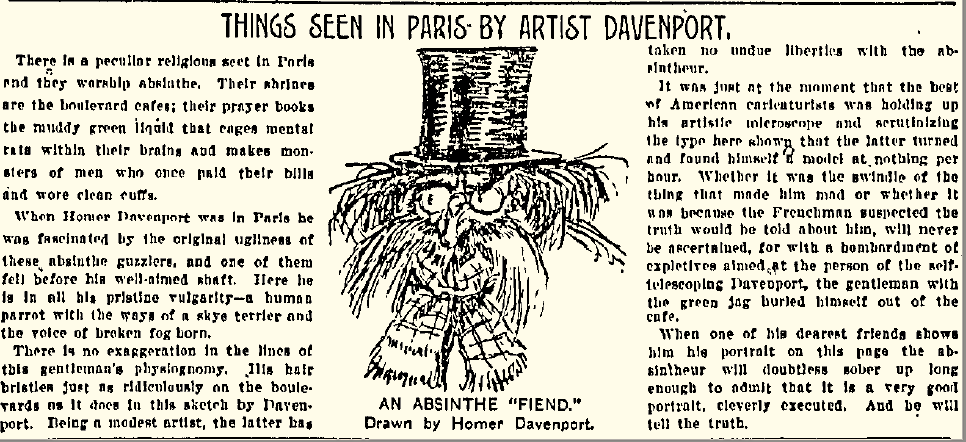
“Wormwood”—as described in the New Testament’s Book of Revelation—was a fallen star, heralded by an angel:
10 And the third angel sounded the trumpet: and a great star fell from heaven, burning as it were a torch: and it fell on the third part of the rivers, and upon the fountains of waters:
11 And the name of the star is called Wormwood: and the third part of the waters became wormwood: and many men died of the waters, because they were made bitter.
![[Revelation 8:10-11] 1805. From Early American Imprints, Series II: Shaw-Shoemaker, 1801-1819 Absinthe 2.png](/sites/default/files/blog/Absinthe%202.png)
Wormwood is also the most contentious ingredient in absinthe, the verdant spirit that was the bane and muse of writers and artists such as Baudelaire, Byron, Poe, Hemingway, Picasso, Joyce, van Gogh…this is the A-list, no first names required. The drinking of absinthe has been identified historically with bohemian decadence and mental health issues which led to its prohibition early in the twentieth century in France, Switzerland and other countries including the United States.
Luminaries and laymen alike indulged in the pursuit of the “green fairy,” alluding to the chartreuse opalescence of that ardent spirit suitably alloyed with a sugar cube and ice-cold water. It’s telling that the Biblical references to wormwood run the gamut from Revelation to Lamentations, for indulgence in absinthe is held to precipitate both experiences.
14 To all my folk I was a scorn, and all the day their song.
15 He made me full of bitterness, and drunk with wormwood strong.
![[Lamentations 3:15] 1695. From Early American Imprints, Series I: Evans, 1639-1800 Absinthe 3.png](/sites/default/files/blog/Absinthe%203.png)
Absinthe is the distilled spirit of the small shrub Artemisia absinthium (the Linnaean name for wormwood) augmented with various herbs, especially anise and fennel. Its dominant taste is similar to licorice. It’s intentionally somewhat bitter, hence its ritual preparation with sugar. Artemisia has been extensively used for medicinal and spiritual purposes. The following entry from The Edinburgh New Dispensary (1796) describes wormwood’s physical characteristics:
Artemisia Absinthium Lin.
Common wormwood; the leaves and flowering tops.
The leaves of this sort of wormwood are divided into roundish segments, of a dull green colour above, and whitish underneath. It grows wild in several parts of Britain; about London, large quantities are cultivated for medicinal use; it flowers in June and July; and after having ripened its seeds, dies down to the ground, excepting a tuft of the lower leaves, which generally abides the winter.
An extract made by boiling the leaves in a large quantity of water, and evaporating the liquor, proves a bitter sufficiently grateful, without any disgustful flavour.
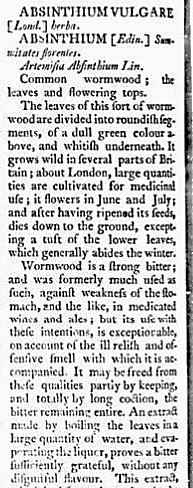
Today we know that absinthe contains trace amounts of thujone, a neurotoxin and convulsant. Modern chemical analysis reveals that the level of thujone in regular nineteenth century formulations of absinthe never approached toxic limits. The adverse effects of absinthe were more likely due to its high alcohol content, up to 150 proof (75%), about twice as strong as other distilled spirits. Nevertheless, the drink’s complex flavor and esoteric ingredients gave it cachet as the source of madness both divine and quotidian. Absinthe drinkers were described as “fiends” and reprobates capable of unspeakable crimes under its influence. The “green fairy” was widely regarded as a destroying angel:
In a night restaurant in Montmartre, a year or two ago, a man rose suddenly from his place behind the tilted champagne in the ice pail and, drawing his revolver, fired at and killed a widely known Paris actor. The affair, which created a great sensation, hid no dark and intimate secret; it was merely a case of drink. The man was an “absinthe fiend” under the influence of momentary madness. All he knew about it next morning that he was in prison awaiting the “instruction.”
In the large centers the working classes have been debauched and ruined physically by this subtle poison, which in the early stages produces an agreeable feeling of intoxication. By its continued employment the character becomes changed. To the brightness and gayety of the first effects succeeds a somber brutishness. Absinthe drunkenness is accompanied by convulsive phenomena and hyperaesthesia, and is thus differentiated from other forms of drunkenness. Other features are the tendency to nervous agitation, insomnia and nightmares. These are followed by hallucinations and profound mental troubles, which may lead to the assize court or to the asylum, or to both.
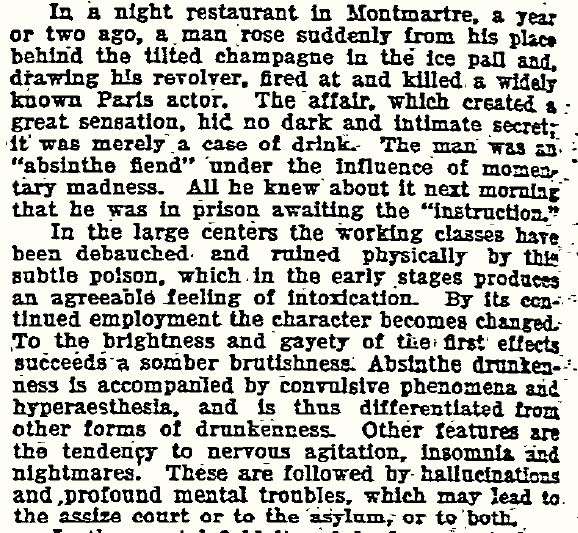
Christianity’s most notable fallen angel was also associated with absinthe in a 1913 four-reel Italian film entitled Satan, based on Milton’s Paradise Lost:
We are now transported to the middle ages. We are brought to the famous monastery where Gerbert, the alchemist, labors. Satan enters and discovers Gerbert’s desire for wealth, the poisonous absinthe is thus invented.
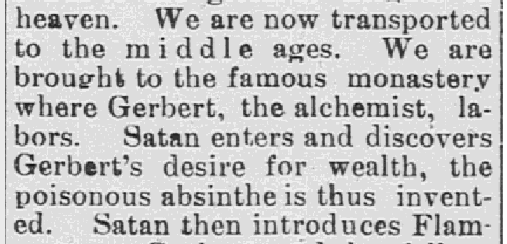
Contrary to modern understanding, a humorous yet informative article from the Baltimore American in 1907 suggested that absinthe drinkers were imbibing more of the essential oils of wormwood and other substances—including cocaine—than is commonly believed to have been the case:
The Nine Ingredients
In those days [i.e., around 1847] it was real absinthe steeped in alcohol. For years past it has been a very complicated alcoholat, colored with spinach, parsley, hyssop, tincture of curcuma and indigo, and containing in dissolution enough of the essence of anise and sweet marjoram to make it yellow and white opalescently when water is added.
This is why scientific memoir writers make so little difference between absinthe and the 89 other pink-edged aperitifs. Some fear the word “absinthe.” Others fear the green color. Cadcac and Meunier, even in their time, disclosed that the manufacturers had added to their so-called absinthe oils of fennel, hyssop, anise, badiane, balm mint, angelica, origan, and mint. Absinthe, fennel and hyssop essential oils are convolsivents. The six others are stupefiants.
You can get them all and several more, including cocaine, in the 89 mauve-striped bitters, vermouths, cocoas, oxygenated, or plain, all the newest ribbon shades; arabesqued, enameled, hand-tooled, silk-embroidered, all “aperitifs” or “openers” of the appetite, drunk before meals by freshmen, sophomores, seniors, even after meals by post-graduates.
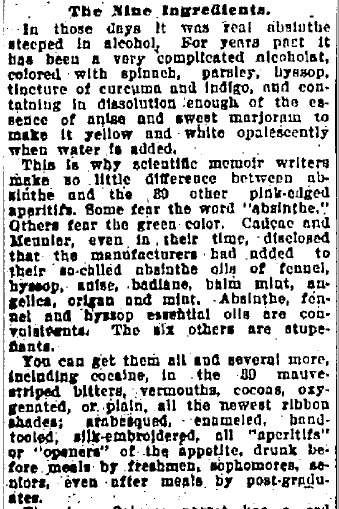
In 1868 a writer in the San Francisco weekly The Elevator described a simple experiment to demonstrate the toxicity of absinthe:
A medical man, who has been studying the different alcoholic drinks served to thirsty people says, “Absinthe is prepared by distilling sprigs of absinthe, angelica root, etc. This mixture appears simple. You [have] heard of Prussic acid, which instantly kills any animal touched by it. Pour six drops of Prussic acid in a quart of water; take another basin, and pour six drops of absinthe in a quart of water. Throw into both basins some live fish. Those thrown into the basin with absinthe will die four times sooner than those thrown into the basin containing Prussic acid.” This statement should startle men who ‘drink like fishes.’
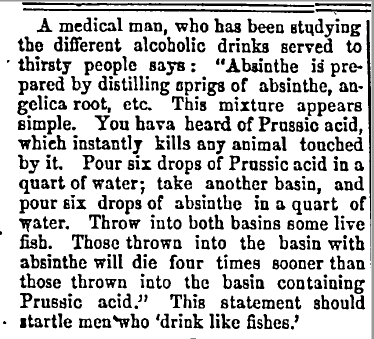
To put the vilification of absinthe in perspective obvious stimulants such as cocaine mentioned above were common ingredients in beverages in the United States until the Pure Food and Drug Act took effect in 1906. Yet absinthe was portrayed as the greater evil in this 1892 article:
Prevalence of Absinthe Drinking
“Absinthe drinking is being carried to that extent to-day,” said Dr. J.G. Brown of Chicago, “that it would seem to possess an irresistible temptation for all, but especially for young men, and not only absinthe but cocaine is being used in larger quantities than I believe has been known at any other time. Some people may argue that absinthe has no disastrous qualities. Do not believe in the argument. Medical science shows that it is the worst of all stimulating drinks. Its effects somewhat resemble those produced by other alcoholic liquors, and some doctors have therefore gone to the extent of declaring that there is no difference in the injury it produces. The best authorities, men who speak from knowledge acquired both by study and experiment, show that when used to excess it produces a mental and nervous condition which seldom follows the abuse of the strongest of other intoxicants. Disarrangement of the nerves, unbearable headaches, terrifying hallucinations—all these things follow its constant abuse. The ultimate end to which these things lead is apparent to the least observing peruser of the daily journals of the country.”
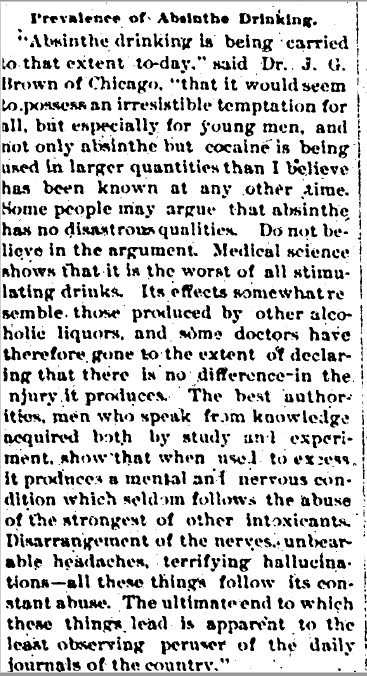
Absinthe was blamed for a litany of ills. For example, along with the use of corsets it was held to be the cause of the low birth rate in France:
The question of population has been a serious one in France for the past 20 years. Every ministry in power has devised some means of encouraging large families. Premiums have been set upon babies, fathers whose cradles have been especially full have been publicly hailed and decorated. Still the birth rate is discouragingly low. Scientists say there are two causes, the abuse of absinthe by the men; the abuse of corsets by the women. Happily neither of these causes promises to affect the size of young America.
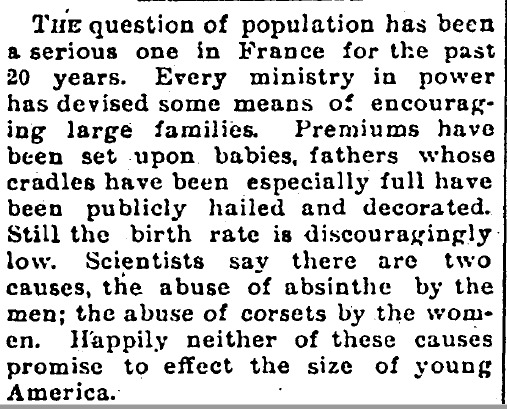
In 1902 absinthe was blamed for French military dysfunction:
Alcohol in the French Army
General Andre lately declared that threefourths of the military offenses in the French army could be traced to the use of absinthe, and he has ordered that there should hereafter be monthly lectures in every garrison on the danger of alcohol.
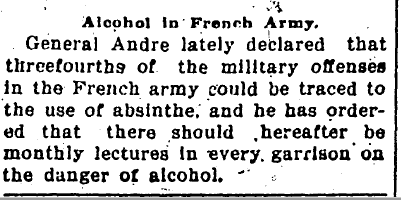
With France in such a predicament could America be far behind? In 1900 the Woman’s Christian Temperance Union thought not:
Absinthe Drinking in America
Absinthe drinking is declared by the women of the Woman’s Christian Temperance Union to be fast becoming a habit that threatens to sap the manhood of the nation as it has that of the French people, and a crusade of extermination is to be waged against it. The edict has gone out from the national headquarters at Evanston that this newer form of alcoholic poison, which is vastly worse than the ordinary beverages to which the union has sworn eternal enmity, shall at once become the object of a bitter war.
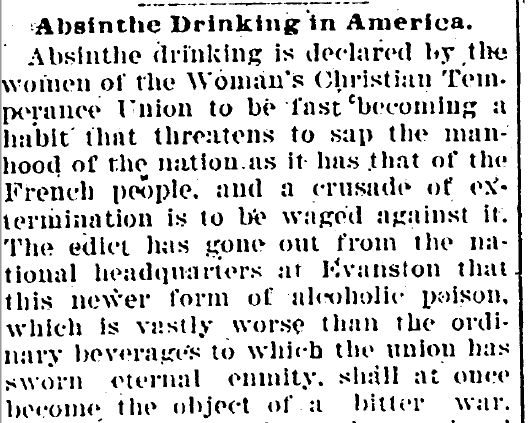
And so absinthe was eventually banned in France, Switzerland and in the United States. The article below is from 1902. France would go on to ban absinthe in 1914.
“Aperitifs” Condemned
The French Academy of Medicine, at the unanimous request of the Chamber, has issued a report strongly condemning the drinks used as “aperitifs,” or appetizers, by the bulk of the French middle and lower classes. After careful analysis Dr. Laborde, who was specially commissioned, declares that every quality of absinthe contains poisonous elements. He discards the fallacy that vermouth, or noyeau, is harmless. Chartreuse is dangerous in a lesser degree, and ought only to be used in tiny medical doses for specific purposes. French gin is a form of wood spirit, and the superstition which makes “vluneraire” [vulnéraire] a popular remedy in certain emergencies is perilous to human life. The Legislature ought, according to the report, to forbid the fabrication of these liquors and the immediate enforcing of the law of 1846 against absinthe. Dr. Laborde considers that the fiscal revenue loses as much as it gains by fraud or adulteration, and by the criminal or mental heredity caused by the terrible spread of alcoholism in France.—London News.
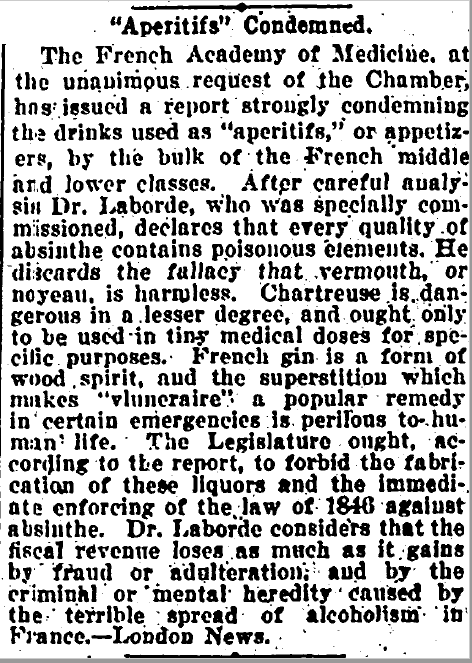
Switzerland, the country where absinthe was first created, had a similar love/hate relationship with the beverage. This article is from 1907.
The “Green Fairy” in Switzerland
In Switzerland May Day was historic, at least for the Canton Vaud. There came into operation on that day a law which may exercise beneficent effects long after the tumultuous assemblies for which the day is becoming the occasion are forgotten.
Some time since the Cantonal Legislature passed an act with the popular approval of prohibiting the retail sale of absinthe, and with the expiry of April 30 it came into effect. But the retailers—that is, the café and restaurant keepers—yield only a half loyalty to the new law. Many of them were giving the drink gratis to customers, “just to clear off stock” and it was observed that many men drank absinthe for the occasion who had never been seen to touch it before. As closing time approached the “green fairy” was “buried” with much hilarious mock funeral ceremony.
Evasion is already at work. As the act only prohibits sale, a number of victuallers are preparing to present known customers with a drink of absinthe a day gratis, just to keep old customers “in the house.” But it is more than doubtful whether such a procedure would not be regarded as illegal.—London Globe.
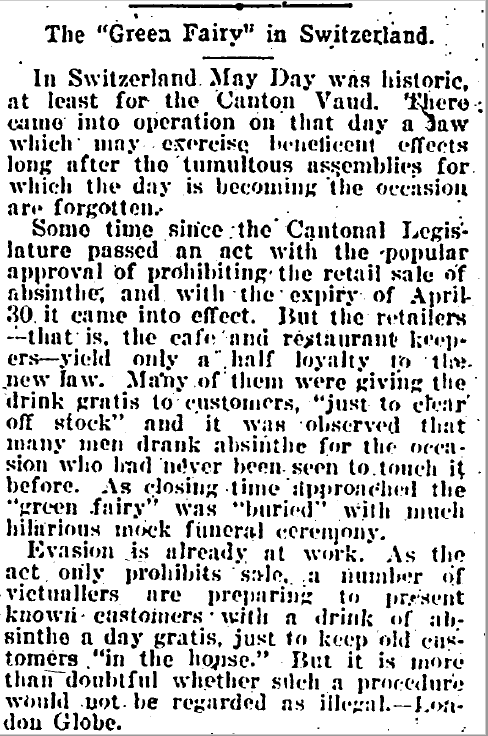
An early advocate of prohibition, Rep. Henry W. Blair of New Hampshire, in an 1876 speech singled out absinthe as “peculiarly formidable.”
The admitted addition of some actively poisonous substances to alcohol, in order to produce a new luxury, is the evil most disastrous. The drink sold under the name absinthe is peculiarly formidable. In this liquor five drachms of the essence of absinthe, or wormwood, are added to one hundred parts of alcohol, *** which has been discovered to exert the most powerful and dangerous action upon the nervous functions. Indeed such are the terrible consequences incident to this agent, that I agree with Dr. Decoisne in maintaining that it ought by legal provisions to be forbidden as an article of human consumption in all civilized communities. Until recently absinthe has not been publicly offered for sale in this country on a large scale. But now, unhappily, the poison is openly announced even here, and the consumption is on the increase.

Absinthe was banned in the United States in October 1912, eight years before national prohibition outlawed the manufacture, transportation, importation and retail sale of all alcoholic beverages.
WASHINGTON, July 12.—The importation of absinthe into the United States and its sale in interstate commerce was prohibited after Oct. 1 next by a pure food decision to-day by Secretary Wilson.
Members of the Pure Food Board expressed the opinion to-day that the decision would virtually abolish the use of absinthe in the United States.

As manifest as were the ills ensuing from the habit of strong drink, in 1921 a writer in the Cleveland Gazette blamed the prohibition of all alcoholic beverages including absinthe for the death of romance. In fairness to absinthe, the horrors of World War I had also diminished the charm of that other wholesale threat to human life:
Romance seems rapidly passing from the world. Wars have become too horrible and wholesale to appeal to the imagination. The law has taken the glamour from the intoxicated, whether it be with absinthe or just near-beer, and now the head of one of our big universities laments that the luring mystery which once surrounded womankind is fast fading away.
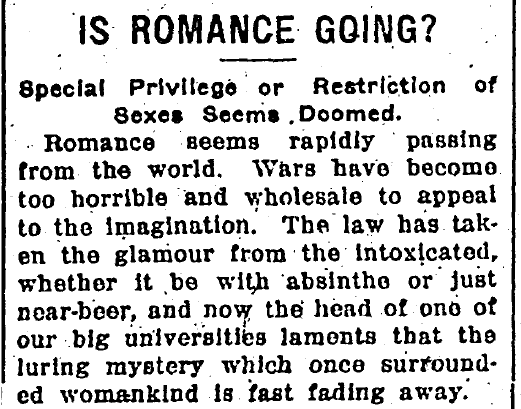
In 2007 following a concerted legal and commercial campaign, absinthe containing no more than ten parts-per-million thujone became legal in the United States. The upper limit of thujone today is about 25% of what it would have been in the nineteenth and early twentieth centuries. There are also marketing restrictions that inhibit the glamour of absinthe as promising psychoactive, medicinal or mystical benefits.
Absinthe today is undoubtedly safer and meets a higher standard of quality than it did in its fin de siècle heyday. Yet it remains an acquired taste that should be taken seriously—and in moderation. Within those bounds this spirit of romance has proven itself to be remarkably evergreen.
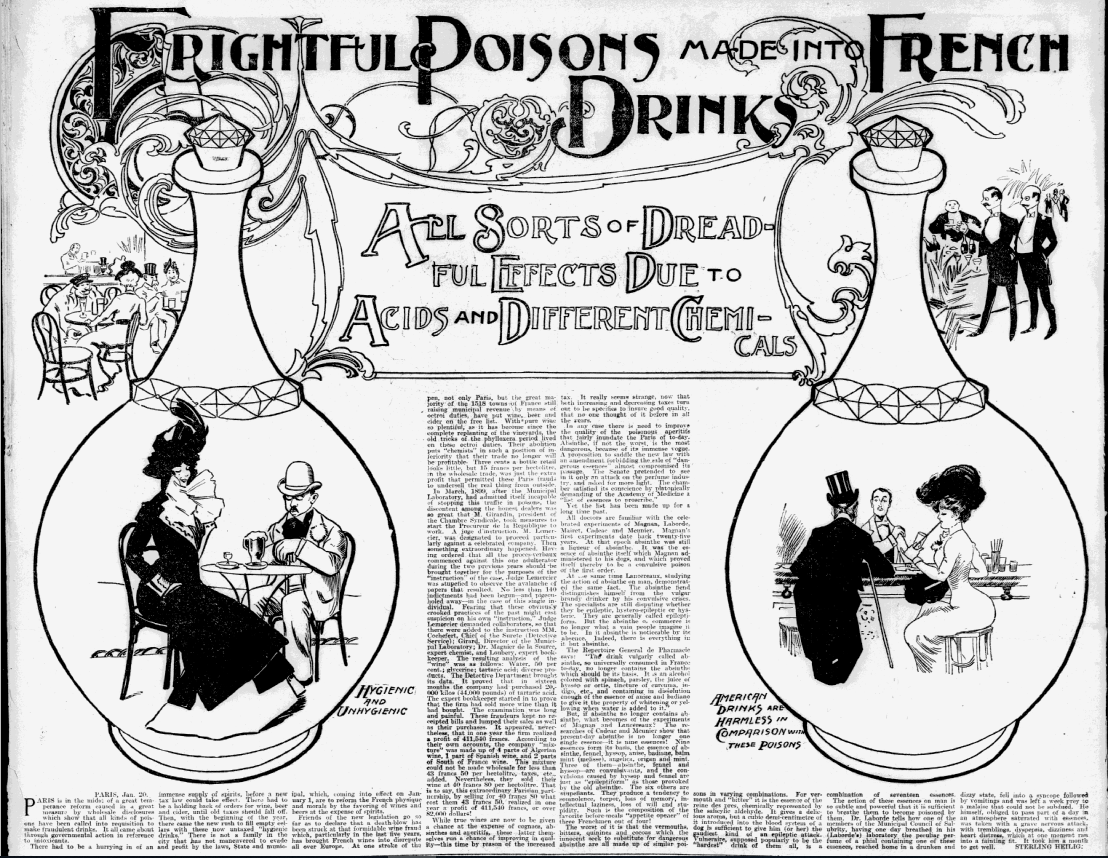
For information on making Early American Newspapers, Series 1-16, available at your institution, please contact Readex.



